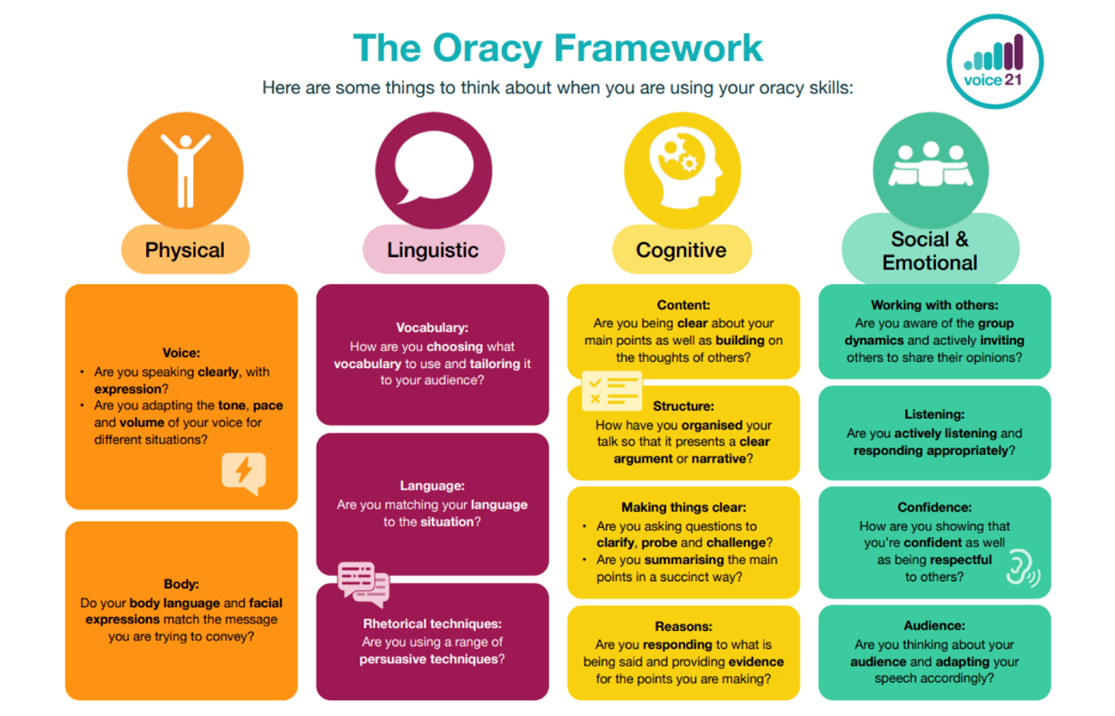Oracy
At Mount Street Academy our Oracy aims are to help pupils develop their speaking and listening skills and become more confident, articulate speakers.
Children’s ability to speak and listen is fundamental to their language development, learning in school and social development. We ensure that children’s oracy skills play a significant part in their learning. We provide children with role play, real life situations, collaborative and problem-solving opportunities to develop these skills. We teach the knowledge, skills and understanding of oracy through a wide range of activities, contacts and purposes including:
- Speaking for different audiences which includes friends, class, teachers and other adults in the school
- Listening and responding, both in face-to-face situations and to broadcast or taped material
- Discussion and group interaction, in settings with different numbers of participants and different levels of formality
- Speaking with talking partners, to create and clarify ideas
- Drama activities, including improvisation and working in role, as well as writing and performing scripted drama
Direct teaching of oracy skills enables our children to develop confidence and a range of talk for different purposes and audiences. We support the children to make links between oral and written language and this is built on across the curriculum. We use a wide range of resources to support our work and train our staff to develop our oracy approach. This includes using Voice 21 resources and training.
We aim to enable children to:
- Be confident when sharing their ideas
- Enjoy playing with patterns of words
- Enjoy talking as part of their play and learning
- Communicate effectively by speaking and listening with increasing confidence, clarity and fluency
- Speak appropriately in a variety of settings for a range of audiences
- Develop a wide range of speaking skills on increasingly complex subjects
- Think carefully and organise thinking before speaking
- Respond sensitively and reflectively to what has been heard
- Reflect on their talk
From Nursery to Year 2, we model quality talk for learning, and through guided work ensure all of our children become successful users of language and who are able to express themselves clearly and communicate effectively. To ensure that our children become confident, successful young people, we ensure we carefully plan for talking within their learning. Children use talk partners, group work and whole class work to share ideas and develop their thinking. Role play, discussion, debate, presentation and decision making also play a significant part in developing and applying oracy effectively. Within drama, we encourage pupils to adopt, create and sustain a range of roles whilst also responding appropriately to others in role. In history, the children re-create scenes from the past and brainstorm feelings and phrases that the characters may have said. In science, the children plan investigations with their group and decide what resources they will need. In maths, pairs of children discuss which is the best method for solving a problem and then share this with the whole class. This 'talk for learning' supports children’s thinking and enables them to learn from each other and structure their ideas. In English lessons we use strategies to encourage all children to verbalise their ideas before they write. For example, within guided group work, children might talk through shared story ideas or make class word and phrase banks. This ensures that they have used the vocabulary and verbalised their ideas so they are more confident to commit their ideas to paper.
We focus on the 4 key components of Oracy in order to ensure children become confident communicators:

The long term aim is for our children is that they independently alternate between the listener and the speaker during conversation. To reach this goal, clear and high expectations and adult scaffolds boost the role of the speaker and the listener. The speaker’s role is clearly modelled and scaffolded by adults, so that all participants actively learn within talk-based tasks and the listener’s role is also scaffolded by adults so they become reciprocal listeners who are equally required to take part in the interaction. To help children learn to communicate well in this way, we provide them with a framework, guidelines and mantras, outlining the essential skills for being both an effective speaker and listener.
This is further supported through our consistent culture of listening in classrooms, so all children feel their voices are valued; for this to happen it is important that we explicitly teach them how to speak and how to listen and know why both skills are important.
To ensure children develop these speaking and listening skills we:
- Model expectations – with designated oracy sessions that allow the children to explore these roles and to have them modelled to them, as well as modelling these leaned skills within lessons across the curriculum.
- Set clear objectives – be explicit about what we want the children to talk about and listen to, and what the end objective of this discussion/conversation is.
- Define clear roles – through the use of talking partners, to scaffold and support children in knowing what their role is within a conversation.
- Scaffold discussions – through speaker and listener guidelines/scaffolds, mantras, sentence frames and sentence stems.
These strategies can be seen used through all learning across the school from Nursery to Year 2, in line with our Oracy progression map and Oracy curriculum (found via the links below). In addition to this, from Reception to Y2 the children have designated time for exploring, developing and embedding these roles.
Talk Assemblies:
As part of our Oracy offer, we have one whole school talking assembly each half term, followed by a classroom based talking assembly, once per week for 3 weeks per half term. These assemblies have a clear structure, explore key speaking and listening roles and are carefully planned and scaffolded, with opportunities for staff to model these roles explicitly and for children to explore these roles in order to acquire them and to be increasingly successful communicators.
